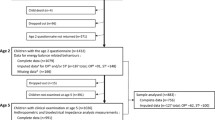Abstract
Background
Television, computer and other causes of increased inactivity are reported to be among the major causes of obesity. This cross-sectional study was aimed to evaluate the effect of television viewing and other daily activities on body mass index (BMI) z-score of early adolescents.
Methods
A total of 860 students and their parents (581) from different socioeconomic level schools were included. They were instructed to fill in a self-designed questionnaire. Weight and height were measured, and BMI z-scores were calculated.
Results
BMI z-score was higher in boys and in those attending high socioeconomic level schools. Children with a BMI z-score >2SD watched television (2.5±0.9 h/day) longer than those with <-2SD (1.6±0.8 h/day) (P=0.027). The three categories (<-2SD, -2SD-2SD, >2SD) differed significantly according to maternal (P<0.05) and paternal (P<0.005) BMI. Linear logistic regression analysis revealed that socioeconomic level, maternal BMI and paternal BMI are factors affecting BMI z-score significantly.
Conclusion
Genetic and/or family environment which may affect the nutrition and activity of adolescents seems to be the most important factor affecting their BMI z-score.
Similar content being viewed by others
References
Anderson PM, Butcher KE. Childhood obesity: trends and potential causes. Future Child 2006;16:19–45.
Black RE, Allen LH, Bhutta ZA, Caulfield LE, de Onis M, Ezzati M, et al. Maternal and child undernutrition: global and regional exposures and health consequences. Lancet 2008;371: 243–260.
Myers EF. ADA Evidence Analysis Library. J Am Diet Assoc 2005;105:S79.
Janssen I, Katzmarzyk PT, Boyce WF, Vereecken C, Mulvihill C, Roberts C, et al. Comparison of overweight and obesity prevalence in school-aged youth from 34 countries and their relationships with physical activity and dietary patterns. Obes Rev 2005;6:123–132.
Eisenmann JC, Bartee RT, Smith DT, Welk GJ, Fu Q. Combined infl uence of physical activity and television viewing on the risk of overweight in US youth. Int J Obes (Lond) 2008;32:613–618.
Dietz WH Jr, Gortmaker SL. Do we fatten our children at the television set? Obesity and television viewing in children and adolescents. Pediatrics 1985;75:807–812.
Gortmaker SL, Must A, Sobol AM, Peterson K, Colditz GA, Dietz WH. Television viewing as a cause of increasing obesity among children in the United States, 1986–1990. Arch Pediatr Adolesc Med 1996;150:356–362.
Laurson K, Eisenmann JC, Moore S. Lack of association between television viewing, soft drinks, physical activity and body mass index in children. Acta Paediatr 2008;97:795–800.
Must A, Bandini LG, Tybor DJ, Phillips SM, Naumova EN, Dietz WH. Activity, inactivity, and screen time in relation to weight and fatness over adolescence in girls. Obesity (Silver Spring) 2007;15:1774–1781.
Hancox RJ, Poulton R. Watching television is associated with childhood obesity: but is it clinically important? Int J Obes (Lond) 2006;30:171–175.
Marshall SJ, Biddle SJ, Gorely T, Cameron N, Murdey I. Relationships between media use, body fatness and physical activity in children and youth: a meta-analysis. Int J Obes Relat Metab Disord 2004;28:1238–1246.
Vaughan KK, Fouts GT. Changes in television and magazine exposure and eating disorder symptomatology. Sex Roles 2003;49:313–320.
Mei Z, Grummer-Strawn LM. Standard deviation of anthropometric Z-scores as a data quality assessment tool using the 2006 WHO growth standards: a cross country analysis. Bull World Health Organ 2007;85:441–448.
Cole TJ, Faith MS, Pietrobelli A, Heo M. What is the best measure of adiposity change in growing children: BMI, BMI %, BMI z-score or BMI centile? Eur J Clin Nutr 2005;59:419–425.
Fredriks AM, van Buuren S, Wit JM, Verloove-Vanhorick SP. Body index measurements in 1996–7 compared with 1980. Arch Dis Child 2000;82:107–112.
Toyran M, Ozmert E, Yurdakök K. Television viewing and its effect on physical health of schoolage children. Turk J Pediatr 2002;44:194–203.
Andersen RE, Crespo CJ, Bartlett SJ, Cheskin LJ, Pratt M. Relationship of physical activity and television watching with body weight and level of fatness among children: results from the Third National Health and Nutrition Examination Survey. JAMA 1998;279:938–942.
Feldman DE, Barnett T, Shrier I, Rossignol M, Abenhaim L. Is physical activity differentially associated with different types of sedentary pursuits? Arch Pediatr Adolesc Med 2003;157:797–802.
Ekelund U, Brage S, Froberg K, Harro M, Anderssen SA, Sardinha LB, et al. TV viewing and physical activity are independently associated with metabolic risk in children: the European Youth Heart Study. PLoS Med 2006;3:e488.
Larios SE, Ayala GX, Arredondo EM, Baquero B, Elder JP. Development and validation of a scale to measure Latino parenting strategies related to children’s obesigenic behaviors. The parenting strategies for eating and activity scale (PEAS). Appetite 2009;52:166–172.
Anderson SE, Cohen P, Naumova EN, Must A. Relationship of childhood behavior disorders to weight gain from childhood into adulthood. Ambul Pediatr 2006;6:297–301.
Huesmann LR, Moise-Titus J, Podolski CL, Eron LD. Longitudinal relations between children’s exposure to TV violence and their aggressive and violent behavior in young adulthood: 1977–1992. Dev Psychol 2003;39:201–221.
Bryant MJ, Lucove JC, Evenson KR, Marshall S. Measurement of television viewing in children and adolescents: a systematic review. Obesity 2007;8:197–209.
Ozmert E, Toyran M, Yurdakök K. Behavioral correlates of television viewing in primary school children evaluated by the child behavior checklist. Arch Pediatr Adolesc Med 2002;156:910–914.
Author information
Authors and Affiliations
Corresponding author
Rights and permissions
About this article
Cite this article
Özmert, E.N., Özdemir, R., Pektaş, A. et al. Effect of activity and television viewing on BMI z-score in early adolescents in Turkey. World J Pediatr 7, 37–40 (2011). https://doi.org/10.1007/s12519-011-0243-2
Received:
Accepted:
Published:
Issue Date:
DOI: https://doi.org/10.1007/s12519-011-0243-2




